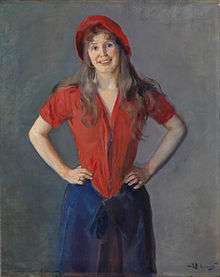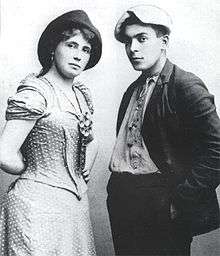Oda Krohg



Oda Krohg, née Othilia Pauline Christine Lasson (11 June 1860 – 19 October 1935) was a Norwegian painter, and the wife of her teacher and colleague Christian Krohg.
Biography

She was the second daughter of public attorney Christian Lasson and Alexandra von Munthe af Morgenstierne. Her maternal grandmother was a Russian princess. She grew up in a liberal-conservative household, along with eight sisters and two brothers. Her brother Per Lasson became a noted composer and her sister Caroline Bokken Lasson a singer and writer.
In 1881 she married the businessman Jørgen Engelhardt (1852–1921), with whom she had two children. She split from Engelhardt in 1883, and divorced him in 1888. In 1885 she became a student of Erik Werenskiold and Christian Krohg, the latter she would marry in October 1888. In 1885, their daughter Nana was born, and in 1889, their son Per, who also would be a known painter.
Paris
In the period 1901–1909, the family lived in Paris. In Edvard Munch's etching kafeinteriør (1893), Oda is surrounded by bohemians and people close to them: Munch, Christian Krohg, Jappe Nilssen, Hans Jæger, Gunnar Heiberg and Jørgen Engelhardt.[1] Oda is said to have had affairs with all of these men apart from Munch. In his book Syk Kjærlihet ("Diseased Love", 1893), Hans Jæger describes a love triangle where he was strongly in love with a woman who was to marry a painter. Oda is said to have been the model for the woman, and the book describes the relation between Jæger, Oda and Christian during the summer and autumn of 1888.
Berlin
In the 1890s the Krohgs moved to Berlin. During a quarrel with August Strindberg, who became provoked when Oda tuned his guitar in front of the guests at a party at Strindberg's favorite bar, "Zum Schwarzen Ferkel", the dramatist Gunnar Heiberg defended her. August Strindberg was known for his bad temper and his several conflicts with others, for no particular reason.
Paris again
Oda Krohg and Heiberg soon fell in love and in 1897, she took one of her children, her son Per, and moved to Paris with Heiberg. Her husband took a position as an art instructor at Académie Colarossi in Paris not long thereafter and Oda obtained an artist's studio in Montparnasse. Within a short time she became acquainted with some of the leading artists in the city, including Henri Matisse. In 1903 she showed at the Salon de Paris, and a year later held her first exhibition at the Salon d'Automne, where she continued to be regularly involved until 1909. During this time she was in a relationship with the poet and art critic Jappe Nilssen. Oda separated from him and returned to her husband. A little while later they returned to Oslo.
Works
Having little formal art education, she quickly absorbed the knowledge of the artistic environment she was a part of. Her debut was in 1886 with Ved Kristianiafjorden (Japansk lykt) («By the Oslofjord (Japanese lantern)»), which now is stored in the National Gallery of Norway. Her first years as an artist are seen as an example of new Romantic painting. Her later portrait works make another, more robust impression. Oda Krohg is known for her landscapes, among them Ved Kristianiafjorden (Japansk lykt) and Ved engen (Kinesisk lykt) («On the meadow (Chinese lantern)», 1889) and other works like En abonnent på Aftenposten («A subscriber to the Evening Post», 1887), Fra festen («From the party», 1892) and Rouge et Noir (1912) and the brave Christian Krohg på Karl Johan («Christian Krohg at Karl Johansgate», 1912). She also painted portraits of, among others, Aasta Hansteen, Ivar Arosenius, Gunnar Heiberg, Johanne Dybwad and Christian Krohg.
Oda was also a central figure in the anti-culture movement of the Kristiania Bohemians[2] (Kristiania-bohemen) in the 1880s and 1890s. Her public image as the "Bohemian Princess" has to some extent obscured the impression of a competent painter.
Despite her wish to become a writer, she published very little during her lifetime.
Legacy
She is buried at the National Cemetery (Æreslund) at Vår Frelsers gravlund in Oslo.
Her life is described in Ketil Bjørnstad's novel Oda! (1983). The song "Sommernatt ved fjorden" (1978) by Ketil Bjørnstad, sung by the operasinger Ellen Westberg Andersen, describes Hans Jaeger and Oda Lasson in a small boat out on the fjord on a summer night.
Further reading
- Anne Wickstrøm. Oda Krohg : maleri. Lillehammer kunstmuseum, 2005. 11 pp. ISBN 82-91388-46-6
- Anne Wickstrøm. «Oda Krohg» In Norsk biografisk leksikon, vol. 5 (2002)
- Anne Wickstrøm. Oda Krohg : et kunstnerliv. Gyldendal, 1988. ISBN 82-05-17392-3
- Anne Wickstrøm. «Oda Krohg» In Norsk kunstnerleksikon, vol. 2, 1983
- Per Krohg. «Oda Krohg : Tale ved Chr. Krohgs fest 18. nov. 1952». In Kunst og kultur, 1953
| Wikimedia Commons has media related to Oda Krohg. |
External links
- (Norwegian) krus.com; Kunstnere i Akershus About her connection to Akershus
- (Norwegian) Sørlandets kunstmuseum About the painting Aftenposten (1887)
- (Norwegian) o-vaering.no Gallery
Footnotes
- ↑ http://194.14.111.31/kultur/feminism.htm
- ↑ Oslo was known as "Kristiania" until 1924
![]() This article incorporates text from a publication now in the public domain: Gilman, D. C.; Thurston, H. T.; Colby, F. M., eds. (1905). "article name needed". New International Encyclopedia (1st ed.). New York: Dodd, Mead.
This article incorporates text from a publication now in the public domain: Gilman, D. C.; Thurston, H. T.; Colby, F. M., eds. (1905). "article name needed". New International Encyclopedia (1st ed.). New York: Dodd, Mead.